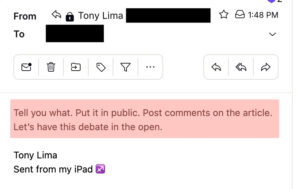Why Hasn’t the California Globe Retracted Its Story?

@TBPInvictus here
If you’re tired of California-minimum-wage-and-its-impact-on-limited-service-restaurant-employment stories, I understand. Leave this page immediately. I’m tired of it, too, but some stories are so factually challenged that they demand a response. So, allow me to address a hot mess of a story that appeared recently in the California Globe. In the interest of your time and my sanity, I’m going to try to confine myself to the worst of the story’s atrocities. Strap in.
Right up top, we have the lede:
Earlier in June, the Globe reported that California has lost just under 10,000 fast food jobs since the new $20 minimum wage for fast food employees was first signed into law late last year, according to the California Business and Industrial Alliance (CABIA).
CABIA cited data and a report from the Hoover Institution at Stanford University.
The “earlier in June” report was fatally flawed. That was detailed by us here and, subsequently, by Michael Hiltzik here. In fact, the author at the Hoover Institution – Lee Ohanian – recanted upon learning that the data in the Wall St. Journal on which he’d relied was not seasonally adjusted.
So far, there’s no follow-up for the badly-mistaken, relying-on-recanted-evidence, uncorrected Globe story. But wait, there’s more:
The Globe spoke with Rebekah Paxton Friday morning about the Bureau of Labor Statistics reports, for clarification.
“Yesterday, they put out a press release claiming that California’s fast food industry has added every month this year,” Paxton said. “The reality is that California lost over 2,500 fast food jobs since January 2024, when looking at seasonally adjusted data.
Ms. Paxton, to her great credit (/sarc), apparently has sufficient smarts to understand that seasonally adjusted data should be the focus. Baby steps.
On to the alleged proof of Newsom’s disaster:
She provided a chart from the Bureau of Labor Statistics, which details the information:MonthNumber of JobsChange in JobsJan 2024742,3261,050Feb 2024741,822-503Mar 2024739,792-2,031Apr 2024739,85059May 2024739,804-46
When using January 2024 instead of January 2023, there is indeed a loss of over 2,500 jobs in just that 5 month period.
For starters, January seems like a somewhat random starting point — the law was signed last September and took effect this April. So, January to May feels a bit arbitrary, but hey, its when the year started.
But here’s the question: Have “over 2,500 jobs in just that 5-month period” been lost? No, dear reader. They have not. The Globe, amazingly, cannot even sum a column of five small numbers.
We have exactly two prints since the law took effect — April and May. They show a net gain of a statistically insignificant 13 jobs added. There were 2k shed in March. Was that related to the minimum wage? We simply do not know; there are always myriad factors at play in our dynamic labor market. What should happen here — but won’t — is that we wait, patiently, and collect a lot of additional data from which we can – maybe – make some inferences.
We move on to:
Paxton told the Globe that the real job losses began the day the Legislature passed the $20 minimum wage hike bill. That would explain why the Hoover Institution compiled the 10,000 fast food job losses.
Why would anyone fire a worker in September to avoid a wage increase 7 months later? This makes little sense.
What happened instead is the end of the summer begins the seasonally weakest period EVERY YEAR. The Hoover Institution’s since-retracted claim that the author relied on, and extrapolated from, was simply a bad number that appeared in the WSJ in March. (“Ohanian acknowledged by email that “if the data are not seasonally adjusted, then no conclusions can be drawn from those data regarding AB 1228,” aka the minimum wage law.”)
Gov. Newsom and his staff including Brandon, are picking numbers and months to serve Newsom’s own false narrative.
This is straight-up fiction. Newsom and his staff tried to set the record straight. It was the Journal, then Hoover, then CABIA, that did all of the cherry-picking, and used a bad set of numbers to do it.
A bit out of sequence, but worth mentioning: The Globe took a gratuitous swipe at LA Times columnist Michael Hiltzik, who’d followed our work here with a piece of his own, citing a couple of tweets on the matter (combined here):
Just one problem here, Gavin: The @latimes got its data mixed up. You sent reporter Michael Hiltzik data from 2023 to show that fast-food employment is up. The wage hike took place Apr 1 2024. That’s not even math. That’s just being able to read a calendar. @GovPressOffice. The @latimes‘ Michael Hiltzik is among the worst reporters in California, and proves it again here: Cites data from last year to prove that fast-food employment is up this year, despite @GavinNewsom‘s wage hike. His numbers aren’t fake, just wrong year. Could happen to anyone with the name “Michael Hiltzik.” @GovPressOffice
Hiltzik (who had been sent nothing from Newsom) had — quite appropriately, since the data were not seasonally adjusted — looked at the numbers on a year-over-year basis and concluded:
As of April, employment in the limited-service restaurant sector that includes fast-food establishments was higher by nearly 7,000 jobs than it was in April 2023, months before Newsom signed the minimum wage bill.
Michael was looking at a May vintage of not seasonally adjusted data when he wrote his June 12 piece, and the year-over-year gain at that time was, in fact, “nearly 7,000 jobs.”
Now, you might expect a reputable media outlet to make a host of corrections or pull the piece entirely. But you’ll note I used the word “reputable,” so don’t hold your breath.
On a related note, I had an email exchange with a Tony Lima (who on a side note definitely wants you to know that he got a Ph.D. from Stanford) about a piece he posted here. He tried — and failed miserably — to take Michael Hiltzik to task for his recent column: “There are three problems with Hiltzik’s analysis.” [Narrator: There were not]. I conveyed that to Professor Doctor Lima in painstaking detail. He then invited me to have the debate in public (while semi-obsessing about my identity):

I took Doctor Professor Lima up on his offer, and posted my accurate critique of his work on Twitter, immediately after which this happened:

So, Professor Lima, PhD, just know that I’m around – you know my Twitter handle and have my email address – if you ever want to continue our discussion.
The post Why Hasn’t the California Globe Retracted Its Story? appeared first on The Big Picture.
https://ritholtz.com/2024/07/why-hasnt-the-california-globe-retracted-its-story/
